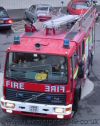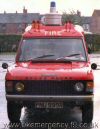Category: FIRE
DG53 FWE This is one of a large number of Incident …

DG53 FWE This is one of a large number of Incident Response Units that the Government has purchased to respond to a terrorist attack in England and Wales. This one is fleet number ‘IRU 010’. These MAN trucks have been converted by Marshall Special Vehicles to carry a wide range of equipment useful for contamination and chemical attack situations among others.
The rear view. Notice the red and yellow battenburg livery and material sides. These slide back to reveal palettes of equipment stored inside. There are no marks to identify the fire brigade county that the vehicle is being used in (and hence they have a non-specific livery). This is because after training nationwide, these vehicles will be collected in, stored and deployed to whichever county needs them in an emergency.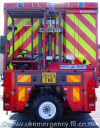
To load and unload the palettes of equipment, this Moffett Mounty fork lift truck is attached to the rear. It is fitted with its own blue flashing light and can be used to move other objects at incident scenes. Scotland has three similar-looking Scania appliances for its terrorist response.
Here are the vehicles in action. The Moffet Mounty fork-lift is unloading two of the containers of equipment from the side of the MAN. Notice how the fork-lift has a blue flashing light, and can lift two containers at a time. The sides of the fire appliance are accessed by pulling back the curtain sides.
The rear view. The rear looks very different without the fork-lift in place. Look how the entire roof of the appliance has lifted by about half a metre to facilitate access to the containers. Each container is labeled (e.g. offside 3 upper) so that every appliance around the country has the same equipment stored in the same place.
DY53 LKU This is one of NYF&RS’s VW Golf estate …

DY53 LKU This is one of NYF&RS’s VW Golf estate fire cars. A number of these cars were purchased in November 2003.
The rear view of the same car. Notice that it has removable blue lights that are attached by magnets to the roof. This means that they can be used on other fire vehicles. Also some magnetic lights cannot be used while in motion as they may fall off.
Here is a West Yorkshire pump in use at a major …

Here is a West Yorkshire pump in use at a major fire in Bradford.
More shots from around the site where polystyrene ignited and caused a major incident for the fire brigade.
A West Yorks. turntable ladder is shrouded in the smoke.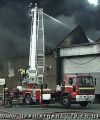
Another turntable ladder is use in the thick, black smoke.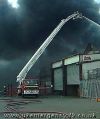
A different view, showing the height of the smoke and the trail of hoses on the ground.
This Jaguar fire car is is a one-off donated and converted …

This Jaguar fire car is is a one-off donated and converted by Chris Coote Conversions of Scunthorpe for the Cadwell Park motor racing circuit. It is fitted with a blue light bar and repeater blue lights behind the grille. The amber beacons are used when the vehicle is on circuit in a non-emergency capacity.
The Jaguar can be manned by two people but is normally solo-crewed as the operators are volunteers.
The fire fighting equipment consists of four portable extinguishers, two “blue” powder ones and two “white” foam. It is normal practice at racing circuits to kill the fire quickly with the powder extinguisher and, if necessary cool the area down using the foam. Consequently once the rear doors are opened the first extinguisher to hand is always the “blue”. A large capacity foam extinguisher is situated in the vehicle. This has to be pressurised before use and is discharged via a hose and nozzle. Once the tank is pressurised it must be discharged the same day so it isn’t pressurised unless essential.











